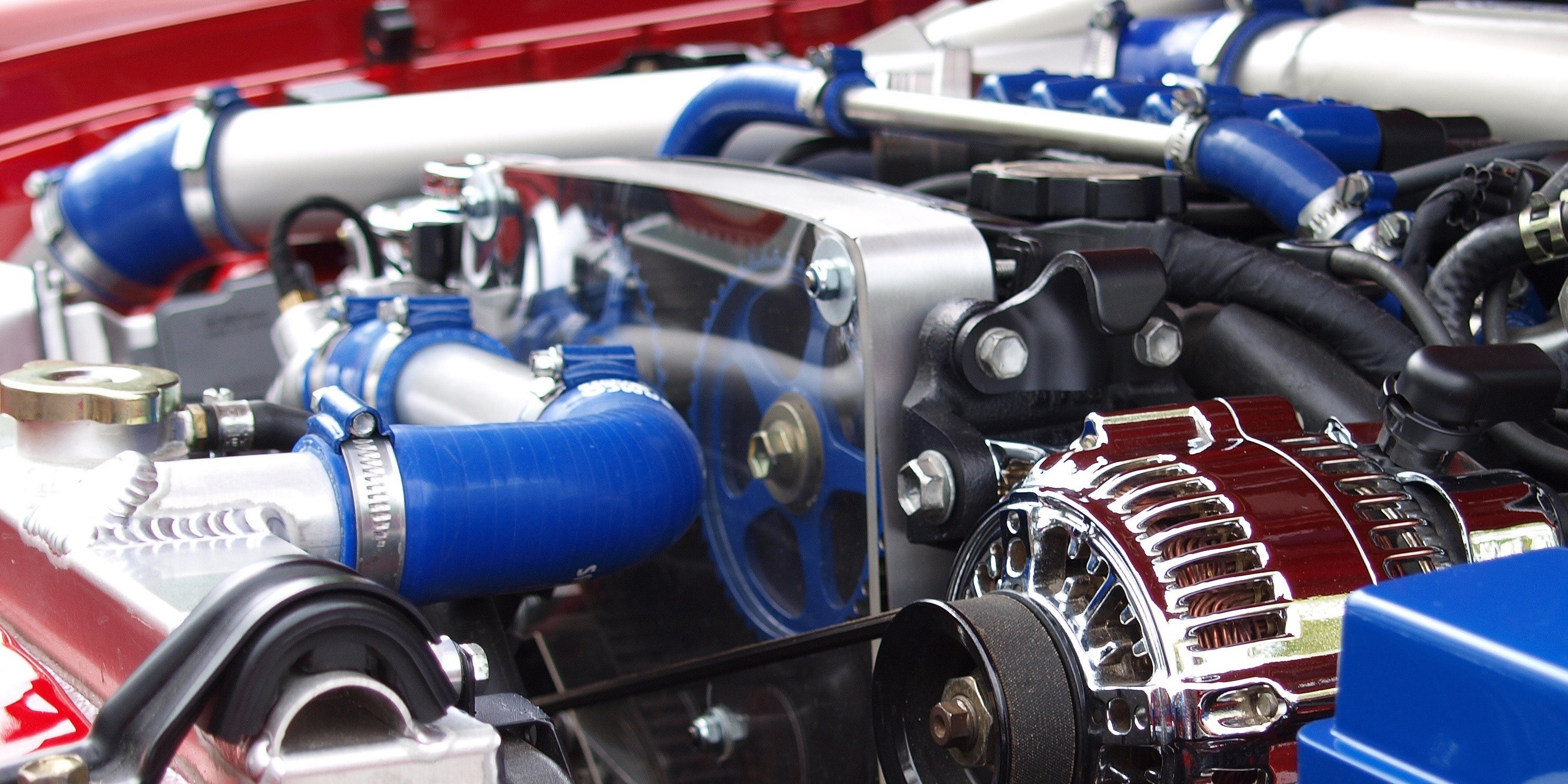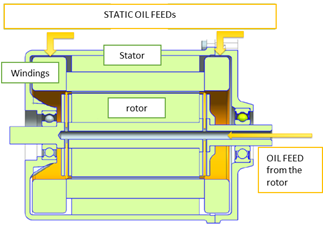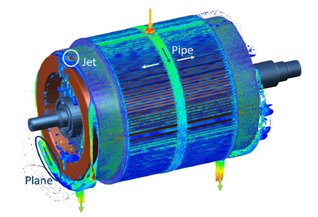
With major OEMs committing to increasing numbers of Electric Vehicles and greater electrification, the total electric car stock is growing and researchers and engineers are focusing on increasing the efficiency of e-machines.
One key technological enabler of electric vehicle is the closer integration of e-machines into transmissions and internal combustion engines (ICEs), and eventually fully integrated powertrains. This means that there will be a shared cooling and lubrication strategy within the transmission and e-machine, tending towards oil cooled e-machines.
With increasing power density motors, the loss density will also increase, meaning that more effective e-machine cooling will be required. Alongside more integration in powertrains, e-machine cooling becomes a factor in the lubrication design and it will become increasingly necessary to use fluid modelling to influence concept level designs.
Fluid modeling for the optimization of e-drives cooling
Currently it is difficult to accurately model fluid flow within enclosed volumes such as transmissions and e-machines with traditional computational fluid dynamics (CFD) methods due to the high modelling and computation time required.
This is currently a barrier at the concept stage to the optimization of oil cooled e-machines. It has been shown that modelling oil within enclosed volumes with rotating components, such as transmissions, can be performed effectively on modest hardware using mesh-less particle-based CFD, like the Moving Particle Simulation method.
MPS Method for enclosed volumes flow simulation
By combining this approach with Finite Element Analysis (FEM), it is possible to model the temperature distribution in the windings of an oil cooled e-machine in a compressed timescale, enabling faster design iterations and more power dense e-machines through thermal optimization.
The use of Moving Particle Simulation (MPS) has diffused for the last years starting from the automotive sector, mainly for powertrain applications, like the simulation of oil splashing and lubrication of engines and transmissions. The benefit of this method is the capability to simulate free-surface flows and liquid jets in very complex geometries, like a complete transmission or engine, in a short modeling and simulation time. This is feasible thanks to the meshless nature of MPS.
In this search for efficiency and performance of e-machines, the use of MPS can support the design of oil injection and the optimization of cooling efficiency. Most of the players in this sector are working on the development of new designs and the capability to simulate and predict the behavior of the system in a fast way and at the early stages of the design is of paramount importance to reduce the number of prototypes and to shorten the development time.
The MPS method is particularly interesting when it comes to the design of high power density e-motors. These systems are very complex from the geometrical point of view and the current trend is to design running-wet e-drives. This means that in order to have a proper cooling level, the coolant is directly injected into the e-motor, like shown in Figure 1. The cooling oil is injected by means of internal channels and holes in the rotor and by means of static inflows. The oil impinges on the windings to reduce their temperature.
This is where the MPS method can support and give an advantage to the designers. The MPS can simulate easily and in a short time, very complex rotor and windings geometries with oil jets / sprays and free surface flows and it can predict the heat transfer coefficient distribution on the surface of the windings.

Figure 1: layout of a running-wet oil-cooled electric motor
Simulation process of oil flow and temperature prediction
During the design process of cooling concepts, the procedure shown in Figure 2 is applied. Different oil injection concepts are compared by simulating the oil distribution in the rotor channels, by calculating the Heat Transfer distribution and by predicting the average and peak temperature values on the vital parts of the e-drive.
 Figure 2: design process of an oil-cooled electric motor
Figure 2: design process of an oil-cooled electric motor
Figure 3 shows the oil flow in an e-motor with three areas, where the characteristics of the flow are different. In some areas, the flow is directly impinging on the surface of the windings and has a high cooling efficiency. In other regions, it is a pipe flow, in others it is a film flowing parallel to the wall. The MPS method can predict the flow and heat transfer phenomena in all these different conditions.

Figure 3: oil flow in a running-wet e-driver (Courtesy of Sebastian Jugelt, IAV GmbH, Germany)
Windings temperature predictions
The procedure described above has been applied and validated on industrial applications both in terms of oil distribution inside the rotor channels and in terms of temperature of the windings. Figure 4 shows the windings temperature map coming for the FEA thermal simulation, with heat transfer boundary conditions from the MPS fluid simulation.

Figure 4: temperature distribution on the windings of an e-drive
For the e-motor shown in Figure 4, the average and peak temperatures for different cooling designs have been compared in a time frame of 3 weeks. This allowed the selection of the best configuration of the cooling system both in terms of oil flow rate distribution, oil injection areas and cooling efficiency.
The growing demand for environmentally-friendly mobility is pushing the automotive industry towards electrification. The next step is integration of transmission and e-drive as a sort of natural evolution of powertrain.
Due to the growth of power density of e-drives, cooling optimization is a key-factor to guarantee the efficiency and life of e-drives. For all these reasons, the effort of the major players in the automotive market is on the development of running-wet efficiently cooled e-drives.
The way the oil is distributed on the windings and the heat transfer phenomena are crucial aspects in the design, and the use of modern mesh-less simulation techniques, like the Moving Particle Simulation method, play an important role in the design process, to predict oil flow and e-drives temperature in advance with respect to experimental tests.
References
[1] L. Martinelli, M. Hole, D. Pesenti, M. Galbiati (2018). Thermal Optimizations of e-drives using Moving Particle Simulation Method. SIA Powertrain Conference, [online].
[2] S. Jugelt (2019) Free flow coolant simulation in electric motors using moving particle semi-implicit (MPS) method. CTI Symposium, Shanghai



